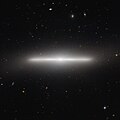File:NGC 4452.jpg

Size of this preview: 600 × 600 pixels. Other resolutions: 240 × 240 pixels | 480 × 480 pixels | 768 × 768 pixels | 1,024 × 1,024 pixels | 2,048 × 2,048 pixels | 3,000 × 3,000 pixels.
Original file (3,000 × 3,000 pixels, file size: 5.96 MB, MIME type: image/jpeg)
File history
Click on a date/time to view the file as it appeared at that time.
| Date/Time | Thumbnail | Dimensions | User | Comment | |
|---|---|---|---|---|---|
| current | 19:49, 14 December 2010 |  | 3,000 × 3,000 (5.96 MB) | Antonsusi | Better jpg-quality, adjusted |
| 14:24, 8 November 2010 |  | 3,083 × 3,083 (3.01 MB) | Jmencisom | {{Information |Description={{en|1=The NASA/ESA Hubble Space Telescope has imaged a striking galaxy called NGC 4452, which appears to lie exactly edge-on as seen from Earth. The result is an extraordinary picture of billions of stars observed from an unusu |
File usage
The following page uses this file:
Global file usage
The following other wikis use this file:
- Usage on ar.wiki.x.io
- Usage on az.wiki.x.io
- Usage on be.wiki.x.io
- Usage on ce.wiki.x.io
- Usage on de.wiki.x.io
- Usage on diq.wiki.x.io
- Usage on el.wiki.x.io
- Usage on en.wiki.x.io
- Usage on eo.wiki.x.io
- Usage on eu.wiki.x.io
- Usage on fa.wiki.x.io
- Usage on fr.wiki.x.io
- Usage on hr.wiki.x.io
- Usage on ja.wiki.x.io
- Usage on kk.wiki.x.io
- Usage on ko.wiki.x.io
- Usage on lb.wiki.x.io
- Usage on mk.wiki.x.io
- Usage on ms.wiki.x.io
- Usage on my.wiki.x.io
- Usage on nl.wiki.x.io
- Usage on no.wiki.x.io
- Usage on pl.wiki.x.io
- Usage on pt.wiki.x.io
- Usage on ro.wiki.x.io
- Usage on ru.wiki.x.io
- Usage on sk.wiki.x.io
- Usage on sr.wiki.x.io
- Usage on tr.wiki.x.io
- Usage on tt.wiki.x.io
- Usage on uk.wiki.x.io
- Usage on uz.wiki.x.io
- Usage on www.wikidata.org
- Usage on zh.wiki.x.io